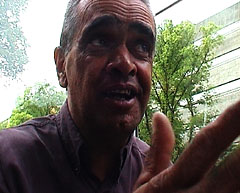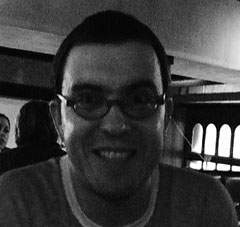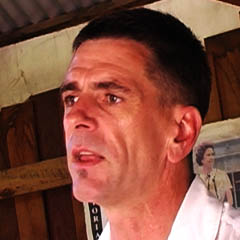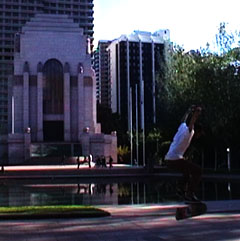
UWC News
UWC TOUR AUSTRALIA 2003, PART 1
Posted: 2004-01-03 | by: JonOn the 5th of December 2003 a group of three people - Jon Brunberg, Anna-Lena Lundmark and Karin Willén - stepped out of a Singapore Airlines airliner at Melbourne International Airport after crossing half the globe in 24-hours. For us three, who are all members of the artist organisation SOC. In Stockholm that arranges the Utopian World Championship, this was the beginning of the Utopian World Championship Tour Australia. The tour would last for a little less than four weeks and it would take us to the eastern parts of Australia: Melbourne, Stanley, Cooma, Canberra, Hay, Sydney, Nimbin and Byron Bay.
 In 2001 a lot of Aussies signed up to take part in the first Utopian World Championship, or UWC as we call it. Six of them made it all the way to the finals where they in the end were beaten by a US citizen living in Sweden. Why so many Australians showed such interest in our competition was a mystery to us since none in our group had even one single contact down under. Later we found out that information about the competition started to spread on Australian mailing lists and that the interest had been further increased after Bernard Lane wrote an article about the "topies" in the newspaper The Australian. When it was time to announce the winner in the competition in January 2002 we were interviewed several times on Australian public service radio. Our initiative was apparently making the news down under and it was obvious to us that we had to find a way to take the big trip to find out what the relation between Australians and Utopia was. Our intention was to meet and interview people with different perspectives on utopia such as artists, politicians, social planners, activists and people representing alternative societies and the aboriginals. We also came to Australia to hand over the Final Document in the first UWC to the Australian Prime Minister John Howard, a task that proved to be a difficult one.
In 2001 a lot of Aussies signed up to take part in the first Utopian World Championship, or UWC as we call it. Six of them made it all the way to the finals where they in the end were beaten by a US citizen living in Sweden. Why so many Australians showed such interest in our competition was a mystery to us since none in our group had even one single contact down under. Later we found out that information about the competition started to spread on Australian mailing lists and that the interest had been further increased after Bernard Lane wrote an article about the "topies" in the newspaper The Australian. When it was time to announce the winner in the competition in January 2002 we were interviewed several times on Australian public service radio. Our initiative was apparently making the news down under and it was obvious to us that we had to find a way to take the big trip to find out what the relation between Australians and Utopia was. Our intention was to meet and interview people with different perspectives on utopia such as artists, politicians, social planners, activists and people representing alternative societies and the aboriginals. We also came to Australia to hand over the Final Document in the first UWC to the Australian Prime Minister John Howard, a task that proved to be a difficult one.
 The Europeans that hit the Australian shores in 1788 declared the continent "terra nullius" - uninhabited land -, a blank paper with endless possibilities. The truth is that Australia at that time was inhabited by one of the oldest surviving civilisations in the world, the Aboriginal people, who had been there for more than 15.000 years. Even though attitudes towards Aboriginal people may have changed since 1788, white Australians still seems to embrace the image of a young country where the dream of a wealthy future in freedom can be kept alive. This image has also always been present in our preconception of Australian society and politics. We’ve always regarded Australia as a western-style capitalist but non-aggressive welfare state that was a forerunner in supplying its citizens with benefits. As John Pilger writes in his book ´A Secret Country´ about the children of the fenians and chartians in the working-class suburbs of Sydney: "They wanted ´Utopia under the Southern Cross´ and their achievements were considerable. Long before Europe and North America, Australia had a legal basic wage, an eight-hour working day, pensions, maternity allowance, child benefits and the vote for women. The secret ballot was invented in the state of Victoria in 1856 and became known as the ´Australian Ballot.´"
The Europeans that hit the Australian shores in 1788 declared the continent "terra nullius" - uninhabited land -, a blank paper with endless possibilities. The truth is that Australia at that time was inhabited by one of the oldest surviving civilisations in the world, the Aboriginal people, who had been there for more than 15.000 years. Even though attitudes towards Aboriginal people may have changed since 1788, white Australians still seems to embrace the image of a young country where the dream of a wealthy future in freedom can be kept alive. This image has also always been present in our preconception of Australian society and politics. We’ve always regarded Australia as a western-style capitalist but non-aggressive welfare state that was a forerunner in supplying its citizens with benefits. As John Pilger writes in his book ´A Secret Country´ about the children of the fenians and chartians in the working-class suburbs of Sydney: "They wanted ´Utopia under the Southern Cross´ and their achievements were considerable. Long before Europe and North America, Australia had a legal basic wage, an eight-hour working day, pensions, maternity allowance, child benefits and the vote for women. The secret ballot was invented in the state of Victoria in 1856 and became known as the ´Australian Ballot.´"
 As you start to scratch the surface of your generalisations, as we had to do during our trip, you always find a more complicated story and it is clear that the welfare policy had deeper and darker motifs besides of its humanitarian aspect. John Pilger continues the previously quoted paragraph by writing: ”The truth was complex and very different from distant idolatry. In Australia, as in South Africa, the white labour movement was founded not on ideals of international brotherhood but, but on fear and the bigotry of white supremacy.” Today the people of Australia have seen the image of their country as a egalitarian welfare state slowly vanish with the new economic climate in the world in which Australian governments have aligned its policies with the global economy and the US and considerably weakened its traditional ties to the UK and the European welfare states.
As you start to scratch the surface of your generalisations, as we had to do during our trip, you always find a more complicated story and it is clear that the welfare policy had deeper and darker motifs besides of its humanitarian aspect. John Pilger continues the previously quoted paragraph by writing: ”The truth was complex and very different from distant idolatry. In Australia, as in South Africa, the white labour movement was founded not on ideals of international brotherhood but, but on fear and the bigotry of white supremacy.” Today the people of Australia have seen the image of their country as a egalitarian welfare state slowly vanish with the new economic climate in the world in which Australian governments have aligned its policies with the global economy and the US and considerably weakened its traditional ties to the UK and the European welfare states.
 So, maybe we did not find any ´Utopia under the Southern Cross´, but we kept our eyes open and certainly found glimpses of utopian thinking everywhere and especially in all the people we met and interviewed. For example Brett Jones, an organising expert, who started the artist run gallery Westspace ten years ago and curated the exhibition "Office of Utopic Procedures" together with Bernard Sachs in 2001. We interviewed professor Lyn Carson about her inspiring work on participation processes and the development of democracy. We visited Wendy Sarkissian who told us some amazing stories from her work as a consultant and facilitator in planning processes and conflicts between groups in society. The permaculture village in Nimbin where she and her husband Karl have their countryside camp is a fascinating eco-community in itself. We had a three-hour session with the Aboriginal activist Gary Foley who told us a different history of Aboriginal past than the official ones, and who, despite his description of a hopeless situation, delivered a sharp and clear vision about the future for Aboriginals in Australia. Peter Tonkin told us about his relation to utopian visions in his work as an architect. Vince Cauley, who is one of the organisers of the Sydney Social Forum served us some brilliant ideas about utopian thinking in Australia and Mark Selkrig and Kim´s cottage Stanley Croft proved to be a private mini-utopia in itself. We will write more about these people and others that crossed our paths in forthcoming articles.
So, maybe we did not find any ´Utopia under the Southern Cross´, but we kept our eyes open and certainly found glimpses of utopian thinking everywhere and especially in all the people we met and interviewed. For example Brett Jones, an organising expert, who started the artist run gallery Westspace ten years ago and curated the exhibition "Office of Utopic Procedures" together with Bernard Sachs in 2001. We interviewed professor Lyn Carson about her inspiring work on participation processes and the development of democracy. We visited Wendy Sarkissian who told us some amazing stories from her work as a consultant and facilitator in planning processes and conflicts between groups in society. The permaculture village in Nimbin where she and her husband Karl have their countryside camp is a fascinating eco-community in itself. We had a three-hour session with the Aboriginal activist Gary Foley who told us a different history of Aboriginal past than the official ones, and who, despite his description of a hopeless situation, delivered a sharp and clear vision about the future for Aboriginals in Australia. Peter Tonkin told us about his relation to utopian visions in his work as an architect. Vince Cauley, who is one of the organisers of the Sydney Social Forum served us some brilliant ideas about utopian thinking in Australia and Mark Selkrig and Kim´s cottage Stanley Croft proved to be a private mini-utopia in itself. We will write more about these people and others that crossed our paths in forthcoming articles.
Images from above: Gary Foley, Vince Cauley, Mark Selkrig, Skater in central Sydney
Quotes from; John Pilger, A Secret Country, Vintage London 1991, p 317-318